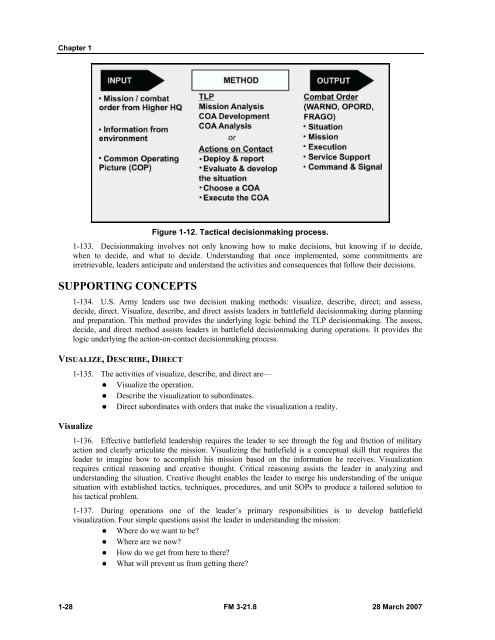Infantry Rifle Platoon and Squad - Sakai
Infantry Rifle Platoon and Squad - Sakai
Infantry Rifle Platoon and Squad - Sakai
Create successful ePaper yourself
Turn your PDF publications into a flip-book with our unique Google optimized e-Paper software.
Chapter 1<br />
Figure 1-12. Tactical decisionmaking process.<br />
1-133. Decisionmaking involves not only knowing how to make decisions, but knowing if to decide,<br />
when to decide, <strong>and</strong> what to decide. Underst<strong>and</strong>ing that once implemented, some commitments are<br />
irretrievable, leaders anticipate <strong>and</strong> underst<strong>and</strong> the activities <strong>and</strong> consequences that follow their decisions.<br />
SUPPORTING CONCEPTS<br />
1-134. U.S. Army leaders use two decision making methods: visualize, describe, direct; <strong>and</strong> assess,<br />
decide, direct. Visualize, describe, <strong>and</strong> direct assists leaders in battlefield decisionmaking during planning<br />
<strong>and</strong> preparation. This method provides the underlying logic behind the TLP decisionmaking. The assess,<br />
decide, <strong>and</strong> direct method assists leaders in battlefield decisionmaking during operations. It provides the<br />
logic underlying the action-on-contact decisionmaking process.<br />
VISUALIZE, DESCRIBE, DIRECT<br />
1-135. The activities of visualize, describe, <strong>and</strong> direct are—<br />
• Visualize the operation.<br />
• Describe the visualization to subordinates.<br />
• Direct subordinates with orders that make the visualization a reality.<br />
Visualize<br />
1-136. Effective battlefield leadership requires the leader to see through the fog <strong>and</strong> friction of military<br />
action <strong>and</strong> clearly articulate the mission. Visualizing the battlefield is a conceptual skill that requires the<br />
leader to imagine how to accomplish his mission based on the information he receives. Visualization<br />
requires critical reasoning <strong>and</strong> creative thought. Critical reasoning assists the leader in analyzing <strong>and</strong><br />
underst<strong>and</strong>ing the situation. Creative thought enables the leader to merge his underst<strong>and</strong>ing of the unique<br />
situation with established tactics, techniques, procedures, <strong>and</strong> unit SOPs to produce a tailored solution to<br />
his tactical problem.<br />
1-137. During operations one of the leader’s primary responsibilities is to develop battlefield<br />
visualization. Four simple questions assist the leader in underst<strong>and</strong>ing the mission:<br />
• Where do we want to be?<br />
• Where are we now?<br />
• How do we get from here to there?<br />
• What will prevent us from getting there?<br />
1-28 FM 3-21.8 28 March 2007

















